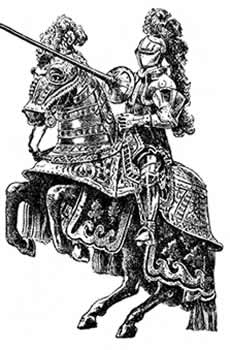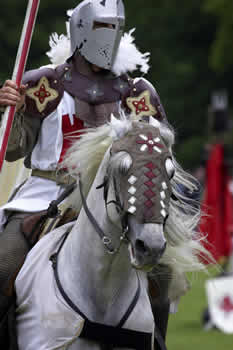“As befits a king’s knight, Tullian.”
—The Key & the Flame

InThe Key & the Flame, Holly finds herself at the mercy of Reynard’s knights. Some are honorable and others are definitely not, but all are sworn to defend their king. Did knights really act like this hundreds of years ago? And did they really joust like they do at Renaissance fairs today?
Medieval Knights
Knights of the Middle Ages—from the eleventh through the thirteenth centuries—were the elite fighting force of their day. They formed a crucial part of a system of government called feudalism. Under feudalism, the king was the top ruler. He controlled all the land in his kingdom, just as Reynard does in Anglielle and as did real kings in Britain, Scotland, and throughout continental Europe.
But it was difficult for a king to control a vast amount of land. He couldn’t travel quickly or dispatch armies very fast if another king invaded; his fastest means of transport was by horse. He controlled his land by entrusting it to barons. The barons built castles that acted as fortresses or strongholds against invaders. Barons controlled smaller portions of land, but they owed allegiance to their king. In order to keep their land, they agreed to fight on the king’s behalf against invaders.
Below the barons were the knights. They were the actual fighting force. The son of a nobleman or baron was often sent away at a young age to another baron’s castle, where he would train to become a knight, or elite soldier, in the king’s army. Once the training was finished, the boy was dubbed a knight in a ceremony and given his own armor and horse. This usually happened somewhere around age 18 to 21. A boy Everett’s age would have been a squire, or knight in training.
A knight swore by God to defend the baron and by extension the king in times of war. Sometimes knights were granted their own land (called a fief) and castle by a baron. In exchange they usually paid some portion of the money they made from their crops or livestock.

Barons or kings often hosted tournaments as a way of testing the skills of their knights. A tournament might last for several days, and knights from around the kingdom were invited to compete. Tournaments included contests in sword fighting, archery, and of course, the joust.
By the 1300s, the joust à plaisance was a controlled contest between two knights on horseback. Each was armed with a lance, a very long pole (sometimes pointed). The knights wore heavy armor and carried shields to protect themselves. Just as you’ll read in The Key & the Flame, jousting contestants began on either side of a low fence or barrier, called a tilt. Each knight galloped toward the other and tried to disarm or unseat his opponent with a blow from the lance. Although meant to be a harmless contest of skills, injuries were common.
An important part of being a knight was following the code of honor. Whether or not they really followed the code, knights swore to defend the honor of women and to protect the weak. At tournaments, a show of dishonorable behavior or unfair play would be greatly frowned upon and would likely result in a knight losing that tournament.
You can read more about the Middle Ages and knights at this ThinkQuest site. Also, check out my Castles & Knights playlist on YouTube for fun videos on all things medieval.
Life in a Medieval Castle by Joseph & Frances Gies (Harper Perennial, 1979)
The Time Traveler’s Guide to Medieval England: A Handbook to Visitors to the Fourteenth Century by Ian Mortimer (Touchstone, 2011)











